Writing Rests #2 – Whole Rest
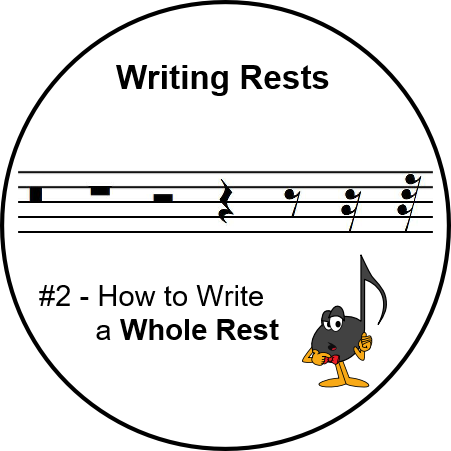
Welcome to the Ultimate Music Theory Blog Series on How to Write Rests.
In the first blog in this Writing Rests Blog Series, we explored How to Write a Breve Rest.
In this second blog, we are going to look at the Whole Rest.
When we teach Rests, a Whole Rest is used to indicate a Whole Measure of Silence in every Time Signature except in 4/2 Time.
In 4/2 Time, a double whole rest is required. This type of rest is called a Breve Rest. (Sorry that I have to write the Time Signature "4/2" as a fraction, but this program will not let me insert the proper Time Signature.)
The Dolmetsch Online Music Dictionary indicates that a Whole Rest is also known as a "Whole Bar Rest". Since a Measure is also known as a Bar, this reinforces the concept that a Whole Rest creates a whole bar (or whole measure) of silence.
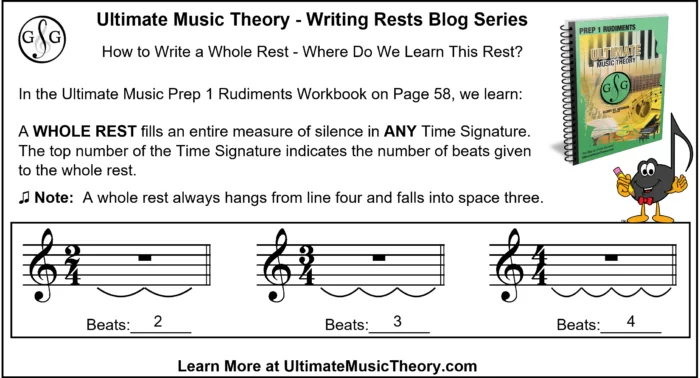
Writing Rests Blog #2 - Whole Rest
Rests are an important part of music. I like to discuss with my Students that sound and silence are both a part of their music.
A Whole Rest is also called:
- a semibreve (in England)
- a semibreve or an interno (in Italian)
- a ronde or a semi-brève (in French)
- a ganze Takt (in German)
- a redonda (in Spanish)
As Students start to learn about rests, we introduce that a Whole Measure of Silence = a Whole Rest. (Page 31 in the Ultimate Music Theory Prep 2 Rudiments Workbook.) Students at this level are only studying Simple Time with a Quarter Note as the Basic Beat.
When a Student progresses to the Basic Rudiments Workbook, they learn that a Basic Beat can also be a Half Note, a Quarter Note, or an Eighth Note. Therefore, a Whole Measure of Silence = a Whole Rest. (When I teach this concept, I really stretch out that word: a WHOOOOOOOOLE Measure of Silence = a WHOOOOOOOOOOOLE Rest!)
Compound Time (and Time Signatures with a 16th note as the Basic Beat) is introduced in the Ultimate Music Theory Intermediate Rudiments Workbook. In Compound Time, a Whole Measure of Silence = a Whole Rest. (Notice a pattern?)
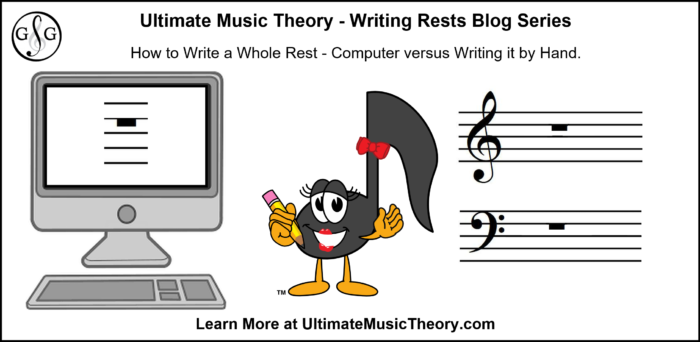
The Norton Manual of Music Notation states that "Rests should be drawn to resemble those found in engraved music as closely as possible".
Engraved Music today is typically music that is written using a Computer Program. It is pretty easy to write a Whole Rest by hand so that it looks just like the Whole Rest that is written using a program like Finale.
How to Write a Whole Rest by Hand
A Whole Rest is a long, thin rectangle that is written to fill the top half of Space #3. If you compare the width of the Whole Rest, it would be approximately the same width as a Whole Note. The Whole Rest must always hang from Line #4.
When I mark Theory, a common Boo-Boo is when a Whole Rest is written to fill Space #3 (like a Breve Rest). This is incorrect.
Use your Ultimate Music Theory Student Whiteboard to practice drawing that thin rectangle that hangs down from Line #4 and fills the top half of Space #3.
Remember when we talked about the "Party Space #3" for Rests (Writing Rests Blog Series #1 - Breve Rest)? Here is another example of a rest that is connected to the Rest Party Space #3! Pretty cool, eh?
Work with your Students so that they learn to write this Rest correctly. This is important! "Close Enough" is not appropriate in Theory.
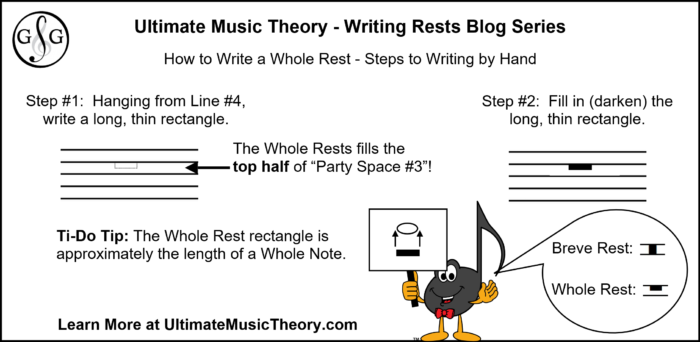
How To Write a Whole Rest Without a Staff
When a Whole Rest is written without a staff, we write a small line above it. This identifies that the Rest is written to hang down from Line #4.
I love that old memory jogger: when you walk along Line #4, you fall into the "hole" (the whole rest that hangs down from Line #4, falling in to Space #3. ("Party Space 3".)
It doesn't matter whether you are writing in the Treble or Bass, or in ANY of the 5 C Clefs, a Whole Rest is always written hanging down from Line #4, falling in to Space #3.
When we write the Whole Rest without the lines and spaces of a staff, we add the small line above it to give the rest a placement.
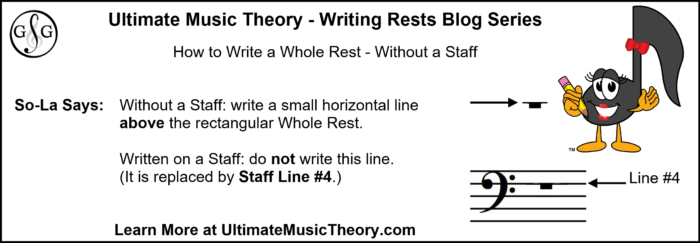
The Writing Rests Blog Series
This Blog Series will be focusing on how to write rests, and not on WHAT rest to write. Each Blog also has a matching Worksheet (with a corresponding Answer Sheet). To get these resources, join the Ultimate Music Theory Membership!
As Teachers, we need to be able to understand why we use the rests that we do. I know that I often questioned why my answer was considered incorrect. When I started learning the Ultimate Music Theory Program, so many of my questions were answered! This made such a difference in my teaching.
I strongly recommend watching the "Teach Rhythm and Rests" online Course. If you don't learn something new, you will at least have reinforced your knowledge. However, I bet (just like me) that you will realize that you didn't know something! Those "Ah-Ha" moments of learning are so exciting.
Thank you for reading! I look forward to seeing you in the Writing Rests Blog Series #3 - The Half Rest Blog.
And, if you missed it, please remember to check out:
- Writing Rests Blog #1 - Breve Rest
Ultimate Music Teachers Membership
♪ LEARN ♪ PLAN ♪ TEACH ♪ GROW
The One & ONLY Ultimate Music Teachers Membership
To Become A UMT PRO!
Your Success Path Starts Here - Go To TeachUMT.com Today!
Keep on Learning... With a Smile and a Song!
Shelagh McKibbon-U'Ren


